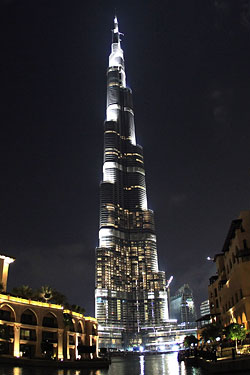
The Burj Dubai, by far the tallest building in the world, will open as planned next month in its namesake city. It has topped out four stories taller than half a mile high—2,684 feet—a chilling figure that was known to very few until it was reached. The tower’s Chicago-based architect, Adrian Smith, confided three years ago that this secrecy was not a marketing gimmick (though it did stir up the press); it was a practical response to some brutal intramural competition. Emaar Properties, the Dubai-based developer that built the tower, was trying to best its rival, Nakheel, most famous for its land-reclamation projects, the Palm islands and the World, which dredged up miles of luxury from the silt of the Persian Gulf. As soon as the final height of the Burj Dubai was known, Emaar feared, Nakheel would unveil plans for something even more ambitious.
Sure enough, as the final height of the Burj Dubai became clear, renderings of the expected counterbuilding were made public. Nakheel’s response, defiantly named Al Burj (The Tower), had a projected height of 4,600 feet.
Savor that in your mind for a moment—sunset, a warm breeze, white clouds wrapping a glass-and-steel spire three and a half Twin Towers tall—because it is never going to happen: Nakheel is the development arm of Dubai World, the state-owned investment company that triggered financial panic around the world two weeks ago when it announced it would seek forbearance on up to $59 billion in debt. Real estate in Dubai had hardly been immune to the general downturn—Nakheel stopped work on its nearly mile-high tower last January—but this latest economic disaster emphatically marks the end of a golden age for those who dream in buildings.
Though they can’t do their jobs without the complicity of real money and real materials, architects are trained to fantasize. It’s what they do best. At the top schools especially, students are encouraged to let their imaginations take them to heights and breadths and topological convolutions far beyond the practical in order to define a personal style or express an idea. Their teachers tend to be architects of the hothouse variety (genus star) whose work, often reliant on very expensive engineering, is unbuildable in any but the most favorable climate.
In the last decade, real-estate nutsiness created those rare conditions all over (even at a few spots in Manhattan), but Dubai was the place where the furthest whimsies of architects—rotating towers! A carbon-neutral ziggurat for 1 million people! A hotel designed by Brad Pitt!—were finally matched by the hubris of clients. Or we might say client, since, one way or another, nearly all of the big digs in the emirate were tied to Sheikh Mohammed bin Rashid al-Maktoum, the visionary ruler who responded to drying oil wells by remaking Dubai into a business and entertainment center, a corporate pied-à-terre, an oasis of capitalism between Europe and the East. Wall Street meets Las Vegas. Meets Xanadu. On crack.
Dubai was a place where people came together to test what was possible. Engineers from London worked with New York architects and Korean contractors to marshal armies of indentured Pakistanis and Indians—globalization at work—to build monuments to their patrons’ ostensibly bottomless wealth. Various marvels rose. More were imagined. But it turns out that even with loose credit, exploited labor, central control, caviar dreams, and the most venal intentions, you still cannot defy the financial laws of gravity.
Have good intel? Send tips to intel@nymag.com.